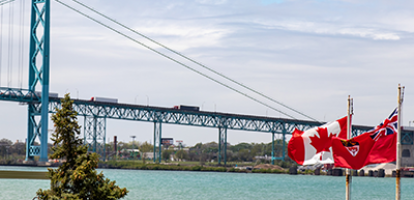From: Glen Hodgson
To: Canadian Currency Watchers
Date: August 25, 2023
Re: US Debt Downgrade Delivers Reminder: Reserve Currencies are not Forever
Fitch Ratings’ recent downgrade of US public debt, dropping it one notch below AAA, is good reason to examine the relationship between US debt and the dollar’s future as a reserve currency. The greenback is just the latest in history’s series of preferred currencies that have been used for foreign exchange reserves and to denominate other assets. But reserve currencies, unlike diamonds, aren’t necessarily forever, and that affects their issuers’ capacity to manage their public debt.
The British pound was the world’s reserve currency in the 19th and early 20th centuries, with a typical exchange rate against the US dollar a century ago, even after the First World War, of around $5 to the pound, a far cry from today’s $1.25. The pound faded after 1945 because of Britain’s massive war debts, the erosion of the empire and the Allies’ choice of the greenback to underpin the fixed exchange rate system negotiated at Bretton Woods, New Hampshire in July 1944. Even though that system collapsed in the 1970s, the dollar remains the predominant global currency, accounting for a modest majority of global foreign exchange holdings.
Operating a reserve currency has two big advantages to the home country: A relatively strong exchange rate (making imports cheaper and suppressing inflation), and the ability to issue, it turns out, nearly unlimited levels of public debt denominated in your own currency at favorable interest rates. And as well, it carries no foreign exchange risk for the issuer. Investors like reserve currency assets because they perceive overall risk as low, believing strong economies can always find the resources to pay their debts – although just printing money and inflating them away is also an option, albeit a misguided one.
Among many Americans, 80 years of the dollar as the world’s reserve currency seems to have nurtured a belief that the world has an unlimited demand for US debt so the federal government can issue unlimited amounts. There is even a school of economic thinking – Modern Monetary Theory – that essentially argues that fiscal deficits and rising public debt simply don’t matter for reserve-currency nations since they can always be financed with bond issues.
Given this mindset, which seems especially common in Washington, D.C., it’s no surprise that public debt as a share of US GDP has tripled over the past 25 years to around 120 percent of GDP, much higher than in a typical AAA-rated jurisdiction. Bill Clinton was the last president to balance the books. Neither Republicans nor Democrats are today seized with the need to balance the budget. It is therefore hard to reconcile what investors want to believe about the low risk of holding US dollar assets and the evident unwillingness of both Congress and the four presidents since Clinton to control the public debt. In this absence of leadership, imagine how hard it would be, should the dollar lose its lustre, either to increase taxes or make major spending cuts or both in order to make good on foreign debt service obligations.
The Fitch downgrade decision has perturbed many conventional economists and financial markets, but it’s hardly surprising. In addition to lack of fiscal discipline in the face of high and rising public debt, Fitch emphasized an “erosion of governance” reflected in the unwillingness to find compromises and build political consensus on big policy issues. Political polarization is clearly not cost-free.
What does all this mean for Canada? The loonie is a minor reserve currency with few of the advantages of the big boys. In IMF data it’s included in the “other” category, which itself represents just three percent of overall international reserves. A one-notch US debt downgrade will have only mild if any lasting effects on Canadian bond and equity markets.
But it remains a warning for us, too. Canada’s deep economic and financial integration with the US always means we are on the front lines if there is stateside turbulence. And the downgrade should remind governments across Canada that effective fiscal management is the best way to maintain or even improve their credit rating and keep the future cost of public debt as low as possible.
This is hardly the end of the greenback as the predominant reserve currency. Nothing else is ready to take its place, not the euro and certainly not the renminbi. But a credit downgrade is notice to investors that risk clouds are forming over US public debt.
Glen Hodgson is a Fellow-In-Residence at the C.D. Howe Institute.
To send a comment or leave feedback, email us at blog@cdhowe.org.
The views expressed here are those of the author. The C.D. Howe Institute does not take corporate positions on policy matters.
A version of this Memo first appeared in the Financial Post.





